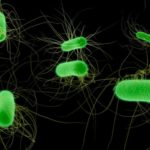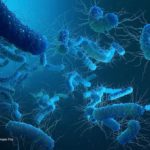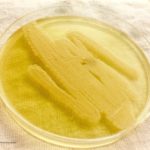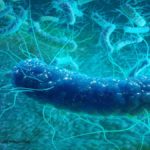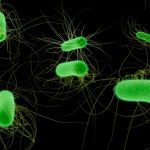A new study shows that an E. coli toxin accelerated colon cancer in study mice, raising the possibility that about two million new cases of colorectal cancer diagnosed every year around the world could originate from food poisoning, even if the cases are brief and mild. The study was conducted at Johns Hopkins University/Bloomberg School of Public Health and published in the January 12, 2022 issue of the journal Cancer Discovery. Certain E. coli bacteria produce a toxin that can damage DNA in intestinal cells. The novel genotoxin is called UshA. The mice studied are genetically susceptible to developing colon cancer, called ApcMinΔ716/+ types. UshA triggers DNA damage and initiates tumor transformation during infections both in vitro and in vivo. This type of infection could … [Read more...]
Can Spinach Be Contaminated With Pathogens At Germination?
We have all heard about the several deadly E. coli O157:H7 outbreaks linked to romaine lettuce that sickened hundreds of people last year in the United States. That contamination apparently occurred while the greens were growing in the field. But can leafy greens such as spinach be contaminated with pathogens during germination? Unfortunately, leafy greens are a main source of foodborne illness, because they are easily contaminated in the field and typically aren't cooked before serving. But that contamination was on the surface of the plant, not internalized into the leaves themselves. Now researchers have looks at the possibility that spinach can be contaminated at germination. Even worse, this contamination can be internalized in the leaf, which means that no amount of … [Read more...]
New Salmonella DNA Test Improves Tracking of the Pathogen in Outbreaks
A new Salmonella DNA test will help improve tracking of Salmonella outbreaks, according to research published in The Journal of Molecular Diagnostics. This should help investigators quickly trace and find the origin of the infection. Food poisoning caused by Salmonella bacteria causes 1.35 million infections every year in the United States. At least 26,500 people are hospitalized because they are so sick with this type of infection, and 420 people die. During an outbreak, speed in identifying and tracing the pathogen is critical to reducing serious illness and death. Traditional methods to find and identify Salmonella serotypes are to first grow the bacteria from samples and then test them to assign a subtype. The new Salmonella DNA test doesn't require first growing the … [Read more...]
Purdue and Kansas State Develop Rapid Tests For E. coli Detection
Researchers at Purdue and Kansas State University have developed new rapid tests for E. coli detection to improve food safety. This will hopefully reduce the number of illnesses caused by this pathogen and save lives. The Kansas State project detects Shiga toxin-producing E. coli in ground beef. The traditional standard test for STEC can take as long as a week to get results, which means that people can get sick before a recall can be announced. This new method takes just one day to obtain confirmatory results. The method uses a "partition-based multichannel digital polymerase chain reaction system." Jamie Henningson, director fo the Kansas State Veterinary Diagnostic Laboratory, said in a statement, "We believe the new digital polymerase chain reaction detection method developed … [Read more...]
Texas A&M Studying Super-Repellent Surfaces For Food Safety
Texas A&M Agrilife Research and the Texas A&M Engineering Experiment Station were awarded a grant from the USDA to study and develop super-repellent and anti-fouling surfaces for foods. These types of surfaces could be used to help ensure the safety of fresh food products. Dr. Luis Cisneros-Zevallos, AgriLife Research food science and co-principal investigator for the project said in a statement, "There is a need to reduce those outbreaks associated with microbial contamination that may take place in different operations along the fresh produce chain. The surfaces we are designing avoid cross-contamination and reduce the risk of biofilm formation.” Some bacteria, such as E. coli, Salmonella, and Listeria monocytogenes, can develop biofilms that help protect them from … [Read more...]
Research Shows Possible Link Between E. coli and Cancer
A new study from the University of Minnesota School of Public Health and Masonic Cancer Center, published in the journal Science, finds a possible association between E. coli and cancer. The scientists have determined how toxins produced by the pathogen interact with and damage DNA on the molecular level. Applications from this study may help doctors understand how toxins affect DNA, and may help them to develop tools to improve chemotherapy treatments. The main researchers are Silvia Balbo, School of Public Health assistant professor, and Peter Villalta, mass spectrometry services coordinator at Masonic Cancer Center. Support was provided by the National Institutes of Health and the National Cancer Institute. The method uses mass spectrometry to study how toxins interact with … [Read more...]
Dying Bacteria Absorb Antibiotics, According to New Study
A new study from researchers at Princeton University and California State University-Northridge has found that dying bacteria can absorb antibiotics, giving other pathogens the chance to survive. The dying bacteria can absorb large amounts of the antibiotic. The paper was published in eLife on December 18, 2018. The work is supported by the U.S. National Institutes of Health, the National Science Foundation, and the University of Waterloo in Canada. That's not the only way pathogens can survive antibiotic doses. They can also delay their growth, grow more quickly, or create biofilms as they grow that shield them from the drug. Researchers created a mathematical model to try to explain this phenomenon. The model "describes the dynamics of bacterial populations facing different … [Read more...]
Scientists Use Machine Learning to Find Source of Salmonella
Scientists at the University of Georgia Center for Food Safety has developed a new approach to identify the animal source of some types of Salmonella outbreaks. The researchers have developed a machine learning approach. The study is published in the January 2019 issue of Emerging Infectious Diseases. Researchers Xiangyu Deng and Shaokang Zhang, along with a team of colleagues, used more than a thousand genomes to predict the animal sources of Salmonella Typhimurium. The project used experts from the Centers for Disease Control and Prevention, the Food & Drug Administration, the Minnesota Department of Health, and the Translational Genomics Research Institute. Almost 3,000 outbreaks of food poisoning were reported in the U.S. from 2009 to 2015. Ninety percent of those … [Read more...]
Researchers Develop Patch called “Sentinel Wrap” to Detect E. coli and Salmonella Bacteria
Researchers at McMaster University in Canada have developed a transparent test patch called "Sentinel Wrap" that can be incorporated into food packaging to monitor for pathogens such as Salmonella and E. coli. The patch, which is printed with harmless molecules that can detect food pathogens, would trigger a signal if it detects bacteria that could be read by a smartphone. The patch doesn't affect the food. The new material was developed in biochemist Hingfu Li's labs at McMaster. Chemical engineer Carlos Filipe and mechanical-biomedical engineer Tohid Didar collaborated on the project. The researchers say that the patch can be incorporated into the production process by food manufacturers. The patch contains tiny drops of DNA sensors that will light up when it finds a pathogen. … [Read more...]
